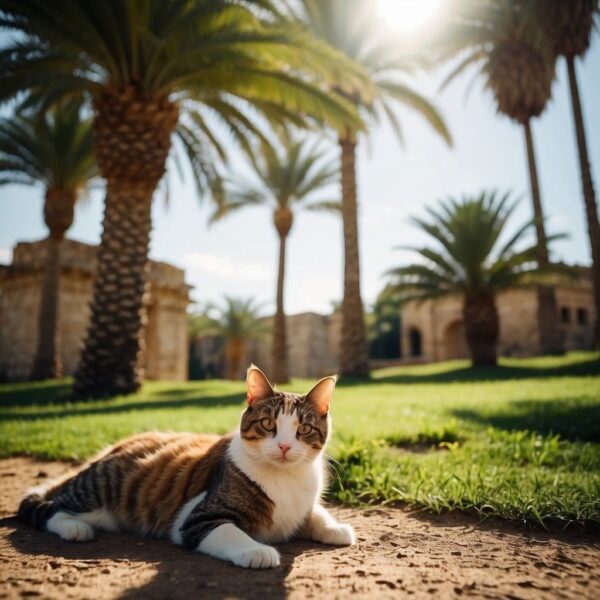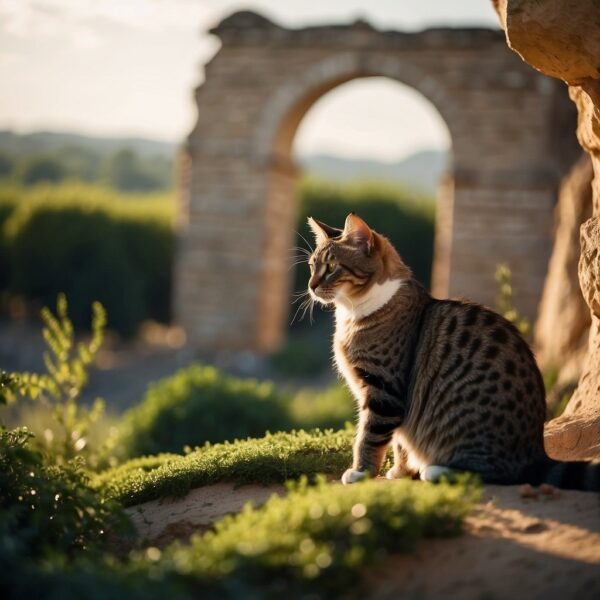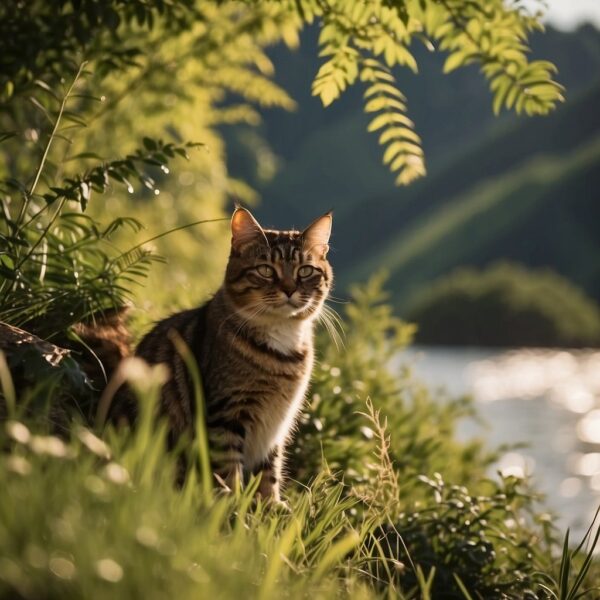
The Cradle of Civilization for Cats and Humans
Sprawled across what is modern-day Iraq, Syria, Lebanon, Israel, Palestine, Jordan, Egypt, and parts of Turkey and Iran, the Fertile Crescent is an arc-shaped region laden with profound historical significance. This swath of land, often heralded as the cradle of civilization, harbored the emergent human societies that have shaped much of our collective history. It was here that some of the earliest advancements in writing, the wheel, law, and agriculture arose, propelling humanity toward urbanization and the establishment of complex societies.
Within this context, the relationship between humans and cats also saw its origin. As agriculture developed, humans began storing surplus crops, which attracted rodents. Wildcats, drawn by the abundance of prey around human settlements, gradually adapted to a life of mutualism with people. This mutually beneficial arrangement eventually led to the domestication of cats. Intriguingly, the roots of our current bond with felines can be traced to the ancient farming communities of the Fertile Crescent, where a symbiotic relationship first emerged between humans and felids.
Key Takeaways
- The Fertile Crescent is recognized as a vital area for early human developments including agriculture and urbanization.
- Domestication of cats occurred in this region, commensurate with advancements in early farming practices.
- The Fertile Crescent’s legacy includes the critical role it played in establishing complex societies and the domestication of felines.

Historical Context of the Fertile Crescent
The Fertile Crescent, a region historically recognized as the birthplace of agriculture, urbanization, and early civilization, has profoundly influenced human history. Its legacy spans the introduction of farming, emergence of cities, and the dawn of ancient civilizations such as Sumer and Akkad.
Mesopotamian Birthplace
The cradle of early civilizations, Mesopotamia, is nestled within the larger Fertile Crescent region. Eridu and Uruk, some of the oldest cities founded in this area, are linked to the origins of written language and the development of the city-state. The Sumerians, in particular, are credited for pioneering cuneiform script, while the Akkadians later expanded their influence through conquests to form a more extensive empire.
- Civilizations: Sumer, Akkad, Babylonia
- Key Cities: Eridu, Uruk, Ur
- Innovations: Script (Cuneiform), Wheel, Irrigation System
History records Ur as a significant economic center, where wealth amassed from trade with regions as distant as India. Notable monarchs, like Ur-Nammu, who commissioned the oldest known law code, predate Hammurabi of Babylon.
Influence on Surrounding Regions
The Fertile Crescent’s innovations in agriculture and city planning extended into adjacent regions, fostering a web of cultural and trade exchanges that spread across the Middle East and beyond.
- Eastward: Persia (current-day Iran)
- Northward: Anatolia (current-day Turkey)
- Westward: Levant (encompassing Syria, Lebanon, Jordan)
The Fertile Crescent’s impact on Egypt was pivotal, contributing to the latter’s own flourishing civilization that paralleled and interacted with Mesopotamian city-states. The region also influenced Europe and Asia, as the knowledge of agriculture and urban planning dispersed, setting the foundation for future civilizations.

Geography and Environmental Factors
The Fertile Crescent, often heralded as the cradle of civilization, owes its profound impact on human and feline companionship to its distinctive geography and the climate that fostered early agricultural societies.
Rivers of Life: Euphrates and Tigris
The Euphrates and Tigris rivers are the lifeblood of the Fertile Crescent, a region encompassing parts of the modern Middle East including southern Iraq. These rivers provided the necessary resources for the growth of Mesopotamian civilizations. It was along these fertile banks that the seeds of human settlement took root, benefiting from the:
- Nutrient-rich soil: Ideal for agriculture.
- Ample water supply: Essential for irrigation and sustaining life.
Climate Impact on Settlements
The climate of the Fertile Crescent has played a critical role in the development of early settlements. The region experiences a variety of climates, but it’s the temperate zones that have historically supported agriculture. The:
- Warm summers: Accelerate the growth of crops.
- Moderate winters: Allow year-round farming activities.
This favourable climate contributed to the establishment of stable, sedentary communities from which both humans and domesticated animals, including cats, thrived.

Development of Agriculture
The transformation from nomadic foraging to settled farming was a pivotal chapter in human history. This section explores the advent of systematic crop cultivation and the establishment of irrigation techniques which were central to the agricultural revolution in the Fertile Crescent.
Crop Cultivation and Irrigation
With the Neolithic Revolution came the shift from forage-based subsistence to agriculture. In the Fertile Crescent, an area known for its rich, arable land, the Sumerians became one of the first people to implement large-scale farming. They cultivated staple crops like wheat and barley, which became the backbone of agricultural support for a burgeoning population.
The rise in population necessitated the control and support of crop yields, leading to the development of irrigation techniques. These systems were critical for providing a reliable water supply in the arid environment. Early farmers constructed canals and dikes, harnessing the Tigris and Euphrates rivers, to ensure their crops received enough water to flourish despite unpredictable rainfall.
From Foraging to Farming
Advancements in the domestication of plants and animals marked the transition from foraging to farming. Domestication involved selecting and breeding certain plants and livestock for desirable traits, such as size or yield, effectively raising crops and herds to support a settled way of life.
This transition not only allowed for the controlled production of food but also gave rise to the first permanent settlements, enabling humans to establish communities and to focus on activities beyond immediate survival. Farmers in the Fertile Crescent engaged in raising livestock, including not just crops but animals, and the supporting economies that developed around these practices laid the foundation for complex societies.

Cats in the cradle of Civilization
Cats played a pivotal role in the cradle of civilization, notably within the Fertile Crescent, where they transitioned from wild animals to human companions, influencing agriculture and various aspects of daily life.
Domestication of Cats and Cultural Significance
The domestication of cats is believed to have commenced in the Fertile Crescent, a region often called the “Cradle of Civilization.” Archaeological evidence combined with DNA analysis indicates that cats were drawn to early human settlements due to the abundance of rodents that plagued grain stores. As farmers settled, they started to value the natural hunting abilities of cats.
Genetic studies, including those performed at the University of California, Davis, suggest that this relationship between humans and cats led to a degree of genetic diversity within domestic cat populations. The partnership was mutually beneficial: cats received a reliable food source, while humans gained control over their rodent population, protecting their food supplies.
In addition to their practical role, cats achieved a significant cultural status, especially in Egypt. They were often depicted in art and revered, with some deities being represented with feline features.
| Region | Significance of Cats |
|---|---|
| Fertile Crescent | Initial domestication and pest control |
| Egypt | Cultural and religious reverence |
Cat breeds, as we know them today, were not a focus in ancient times; instead, the concept of natural breeds developed based on the cats’ adaptation to the environment and the roles they played in human societies.
Contribution to Agriculture and Society
Cats’ contribution to agriculture in the cradle of civilization cannot be understated. By keeping rodent populations under control, they indirectly preserved grain stores and ensured that farmers had successful harvests. This allowed civilizations within the Fertile Crescent to flourish, supporting denser populations and leading to complex societal structures.
The relationship between humans and cats evolved from a functional partnership to one where cats became valued as pets for their companionship. This transition is evident in how cats are often found buried alongside humans in ancient graves, suggesting an emotional bond between the species.
- Role in Agriculture: Pest control and grain protection.
- Evolution into Society: From working animals to companions.
Rise and Structure of Cities
The Fertile Crescent, a region rich with verdant land and life-sustaining rivers, saw the emergence of early cities as humanity transitioned from nomadic to sedentary lifestyles. The growth of these urban centers was a hallmark of Mesopotamian civilization, fostering advances in trade, administration, and the architectural arts.
Urbanization and the City-State
As the Neolithic Revolution took root, the Fertile Crescent birthed the world’s first urban centers. Among them, Uruk, Eridu, and Ur stood out in Mesopotamia, not just as thriving hubs of habitation but as vanguards of a new socio-political model—the city-state. These city-states were characterized by:
- A centralized government that oversaw trade, distributed resources, and regulated religious practices.
- Diverse economic activities, including farming, trade, and craft specialization.
Such urbanization facilitated a network of trade that spanned across regions, making cities vital nodes in the exchange of goods, culture, and ideas.
Architectural Arts and the Ziggurat
Mesopotamian architecture is perhaps best epitomized by the ziggurat, a massive structure that served as both a religious sanctuary and a symbol of civic pride. These terraced pyramids, composed of a series of receding platforms, represented:
- Religious significance, as they were often dedicated to a patron deity of the city.
- An engineering triumph, showcasing innovative construction techniques and materials, like sun-dried and kiln-fired bricks.
Notable ziggurats, such as the Great Ziggurat of Ur, dominated the cityscape, reflecting the importance of theocratic principles and the rulers’ connection to the divine in city planning and structure.
The Legacy of the Fertile Crescent
The Fertile Crescent is a region that has profoundly influenced the development of human civilization, where the relationship between people and cats may have its roots. This area is not only central to the birth of agriculture but also to the enduring bond between humans and felines, with genetic studies suggesting domestication in this region.
Impact on Modern Societies
The Fertile Crescent is widely regarded as the cradle of civilization, where the earliest development of agriculture during the Neolithic period supported the rise of cities and complex societies. This agricultural innovation directly impacted Europe and Western Europe, with many of the staple food crops and the domesticated animals integral to these regions’ development hailing from Mesopotamia.
- History and Culture: Vital technological and social advancements originated from the Fertile Crescent and spread throughout ancient empires, influencing legal systems, languages, writing, and education.
- Genetic Markers: Current research points to this region as the origin for the genetic domestication of cats, which signifies its impact on modern cat fanciers and the global appreciation of these animals.
- Traditions and Heritage: Many modern religious, cultural traditions and the Western world’s values trace back to the legacies of Mesopotamian and Nile River civilizations.
Preservation of the Fertile Crescent’s Heritage
The Fertile Crescent holds numerous archaeological sites, which are critical to understanding the human past and the historical human-animal relationship. In 2018, certain sites within this region were recognized and designated as UNESCO World Heritage Sites, ensuring that future generations can study and appreciate this rich heritage.
- Archaeological Sites: They provide insight into the agricultural practices and the domestication process of animals, including cats.
- Cultural Preservation: Guarding these sites helps maintain the traditions and culture of the Fertile Crescent, offering a window into the lives of those that shaped history.
- Heritage Sites: The recognition by bodies such as UNESCO underscores the intrinsic value of these locations, not just for the region but for the broader story of human civilization.
Frequently Asked Questions
The Fertile Crescent is often cited as the birthplace of agriculture, leading to significant advances in human civilization. Cats in the cradle of civilization is when the feline-human bond was established. These questions delve into the essence of this region’s historical importance.
What role did cats playin the cradle of civilization?
Cats played a pivotal role in the cradle of civilization, notably within the Fertile Crescent, where they transitioned from wild animals to human companions, influencing agriculture and various aspects of daily life.
Which empires thrived within the boundaries of the Fertile Crescent?
Several ancient empires flourished within the Fertile Crescent, including the Sumerians, Akkadians, Babylonians, Assyrians, and Persians.
What are the main reasons behind the Fertile Crescent’s designation as a crucial area for ancient civilizations?
Its rich soils and conducive climate for agriculture allowed for the growth of crops that led to the rise of sedentary communities and eventually complex societies.
How did the geography of the Fertile Crescent contribute to its label as the cradle of civilization?
The geography of the Fertile Crescent, defined by the Tigris and Euphrates rivers, provided water for irrigation and fertile land for agriculture, which supported the development of early human settlements.
Can you list key facts that highlight the significance of the Fertile Crescent in ancient history?
Key facts include the domestication of plants and animals, the invention of the wheel, the development of cuneiform script, and the establishment of trade routes.
Which modern-day countries encompass the region historically known as the Fertile Crescent?
The Fertile Crescent covers parts of the modern-day countries of Iraq, Syria, Lebanon, Israel, Palestine, Jordan, Egypt, and Turkey.
What impact did the Fertile Crescent have on the development of human societies?
The Fertile Crescent was the setting for major human advancements such as the development of agriculture, urbanization, and the emergence of the first complex societies.